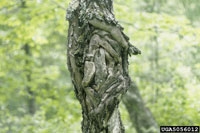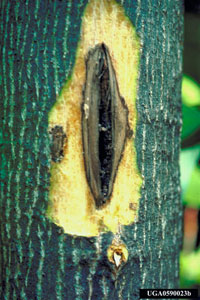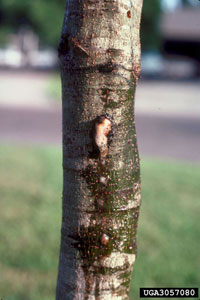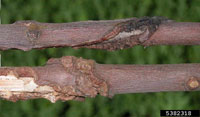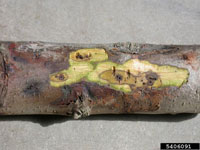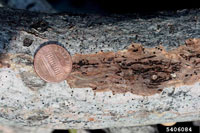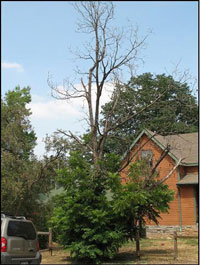Extension > Garden > Diagnose a problem > What's wrong with my plant? > Deciduous Trees > Black Walnut > Dead branches or branch dieback
Black Walnut > Trunk/Branches > Dead branches or branch dieback
1 of 4
Perennial nectria canker
Neonectria ditissima
- Early canker symptoms are small and difficult to see, usually forming a darkened, depressed area beneath smooth, young bark
- Sunken round to oval cankers with target shaped ridges of barkless wood on large branches or main trunk
- Red to reddish orange raised cushion like bumps can occasionally be seen on the edge of the canker
- Dead branches and twigs killed by girdling cankers
- More information on Perennial nectria canker
2 of 4
Fusarium canker
Fusarium solani
- Cankers are elongated strips of cracked sunken bark on lower trunk of young trees
- Wood is stained dark brown to black under bark in cankers
- Occasionally cankers will form higher on the trunk or on branches
- Wilting, canopy dieback and basal sprouting may accompany cankers
- Common on trees with cracks from cold damage
- More information on Fusarium cankers
3 of 4
Flat headed apple tree borer
Chrysobothris femorata
- Older tunnels cause cracks in bark, froth oozes from openings
- Infected areas of tree show sunken, darkened areas of bark
- Larvae tunnel under bark of large branches and trunk
- Can cause dieback or entire tree can be killed, especially young trees
- Larvae is yellow with no legs
- Adult is ¼ to ½ inch long, flattened beetle, ranging from metallic brown to dull gray
- More information on Flat-headed apple tree borer
4 of 4
Thousand canker disease
Geosmithia morbida
- Leaves on one to several branches in the canopy turn yellow, wilt and turn brown
- Dead branches appear in the top of the tree, the tree eventually dies from the top down
- Groups of young green shoots often form on the lower trunk or branches of infected trees
- When the bark is peeled back, numerous gray to black oval cankers can be seen, often with borer galleries
- Bark surface may show no symptoms or may exhibit an amber stain or cracking immediately above cankers
- 1/32nd inch or smaller exit holes from the walnut twig beetle may be visible on dead and dying branches
- Currently not found in MN. If suspected, report it to the Minnesota Department of Agriculture at the "Arrest the Pest" Hotline: 651-201-6684 (metro) or 1-800-545-6684 (Greater Minnesota)
- More information on Thousand Cankers Disease



